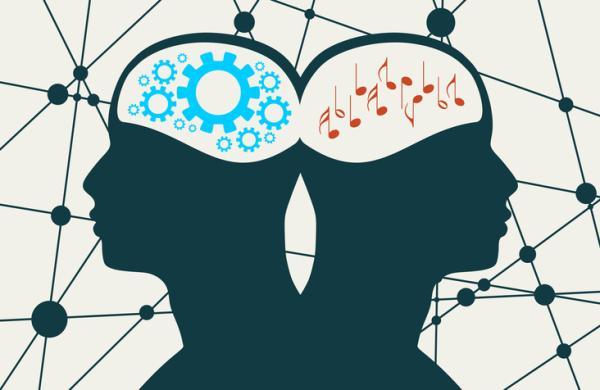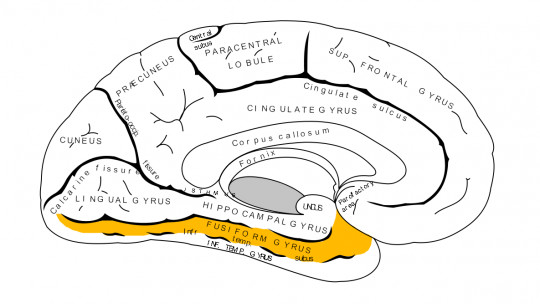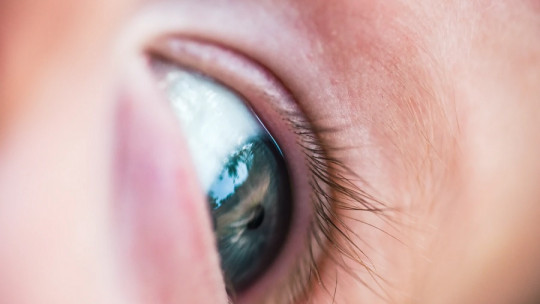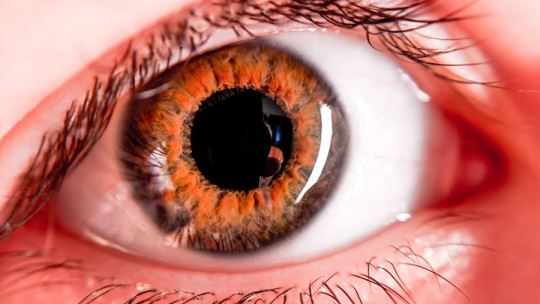Imagine trying a dessert, say, strawberry shortcake, and associating its flavor with the color purple. Or make sure the color orange is associated with a specific musical note. Here is a description of how people who experience synesthesia experiences can perceive the world, which can be very diverse and profound.
If you want to know this phenomenon better, don’t miss this PsychologyFor article in which we will explain the types of synesthesia that exist and her CARACTERISTICS Discover how many synesthesias there are and how they differ from each other.
What is synesthesia
According to its Greek etymology, the word synesthesia comes from the words – syn, together; aisthánesthai, perceive – meaning “simultaneous perception.” More precisely, it can be defined as an intermodal and transmodal phenomenon that consists of the perception of a piece of information through at least two different sensory channels , among them, the one preferred by the type of perception and another. In other words, if you hear a sound and smell a particular smell, you are having a synesthetic experience.
Although initially it was only interpreted as an expression of psychopathology (specifically hallucinations), in more recent times it has been studied with great interest, since it is considered an absolutely normal, although rare, perceptual modality that denotes a particular sensitivity.
Qualities of synesthesia
At least four qualities of synesthesia can be listed:
- Is stable : the subject who perceives a piece of information synesthetically will tend to perceive it with this modality throughout life.
- It is real : synesthesia is an expression of a real perception of the subject, which is not just imagined.
- It is involuntary : synesthesia is carried out automatically, as if it were a reflex.
- It is unidirectional : If by listening to a certain noise you can also perceive a certain perfume, it is not said that by smelling this perfume you can hear the noise in question. This means that the connection between one direction and another is in only one direction.
If you want to know more, in this article we tell you what synesthesia is in psychology: causes and types.
Linguistic synesthesia
Linguistic synesthesia is the activation of various senses due to the association that the subject makes between a word and another type of sensation. A person who experiences this type of synesthesia. also called grapheme-color, can associate individual letters of the alphabet or numbers (graphemes) with a specific color In some cases, even entire words can have their own tone.
This type of synesthesia tends to appear during the first school years, when the child comes into contact with graphemes for the first time. This type of synesthesia is strongly influenced by experience mainly responsible for the association itself and for all the types of synesthesia that have been identified so far.
Grapheme-color synesthesia is one of the most widespread and studied. In fact, some people find it very beneficial to have grapheme-color synesthesia, as it has been shown to help memory and, by extension, learning. Discover how to improve memory for studying in this article.
Phonosymbolic synesthesia
In this type of synesthesia what happens is that some words or phrases are composed of particular linguistic sounds to make the pronunciation refer to a synesthetic experience in which, in addition to sight, the auditory canal is also involved. For example, the poetic expression “crunch the leaves” presents an alliteration so that the reader, while pronouncing Those words, can hear the sound of leaves moved by the wind.
Representative synesthesia
In cases of representative synesthesia, there can be both a representation of aesthetic synthesis, when at a multimedia level a product is reached that involves the activation of several senses. as an aesthetic translation, when a product monomedial, like a painting, It is studied with the intention of also activating another sense
Perceptual synesthesia
Pure synesthetic perception is a phenomenon that does not involve other cognitive processes, but rather refers to the perception of data through multiple sensory channels In the case, for example, of individuals capable of “seeing colors” of words. It is a non-pathological condition, but rare in terms of diffusion in the population.
Ordinal linguistic personification
In ordinal linguistic personification, the synaesthete perceives ordered sequences as numbers, letters, days or months cas if they had personality and gender traits intrinsically different. For example, the synaesthete may feel that the letter A is female, the letter T is male, and the letter M is genderless.
Additionally, you may also perceive number 5 as subtle and number 9 as demanding. Sometimes even letters or numbers have personal relationships with each other. For example, B and R are friends and neither of them can stand Y.
Chromesthesia
This type of synesthesia is also known as color sound synesthesia and can be explained simply as see the sounds In chromesthesia, the sounds heard by the synesthete are associated or perceived as particular colors. The synaesthete hears sound like everyone else, however, in any case in which the sound is heard, he simultaneously and naturally experiences a color that remains more or less constant with that specific sound.
Some chromesthesia synaesthetes take advantage of their condition by using sounds, such as playing a piece of music, as a way to help them relax.

Spatial sequence synesthesia
Spatial sequence synesthesia is sometimes called visual-spatial synesthesia and is one of the most intriguing types of synesthesia, where sequences like Numbers, letters, months and dates are perceived as points in space A synaesthete who experiences this phenomenon can see the spatial layout in his “mind’s eye” or in the real space around him.
For example, there are synaesthetes with spatial sequence synesthesia who, when thinking about letters, may see A further than B and perhaps B higher than C. The arrangement can take different forms, for example, columns, spirals or circles.
Another example of people with this type of synesthesia is that they perceive the time on a clock as located at specific points in the space around them. Therefore, 12 hours have a fixed position, as do hours 1, 2, etc. You can turn to the position of each hour, to concentrate on it and move towards it.
Mirror touch synesthesia
This is one of the rarest types of synesthesia and one that has the greatest chance of being a acquired condition (as opposed to congenital) in a synesthete. In mirror contact synesthesia, the synestheta feel the same sensations as another person The sensation of touching the mirror can be activated by real situations, in person or by looking at someone on a screen.
For example, while watching a doctor place a cold stethoscope on her baby’s back, a mother feels the sensation on her back. Another example would be while watching a friend rubbing a sore spot on her shoulder, feel the same sensation of rubbing on the shoulder. Or perhaps, while he is sitting next to someone on the bus who starts grinding his teeth, the synaesthete feels the same uncomfortable sensation in his mouth.
Auditory-tactile synesthesia
Auditory-tactile synesthesia occurs when The sounds heard by the synesthete produce a tactile sensation in certain areas internal and external of the body. A sound may be perceived as a tingling sensation for one synaesthete, while for another that same sound is perceived as the pressure we normally associate with something pressing on our skin.
The sounds may be reported as sensations of heat or cold, as if they were being tickled, as if they were brushed by a feather, or as electric shocks.

Numerical synesthesia
In numerical synesthesia, the synesthete involuntarily sees a mind map of any group of numbers you think about The arrangements in the numerical form of synesthesia differ from the conventional number line we are taught in school and can be idiosyncratic (unique to each synesthete), and unchanged for the entire life of the synesthete.
The synaesthete may have a particular form for the months of the year and another for the dates. Furthermore, the numerical shapes that are perceived are not linked to colors and do not necessarily possess any form of symmetry. Number shapes can be complex or simple and can involve curved or straight lines or a combination of both.
Lexical-gustatory (and sound-gustatory) synesthesia
A person who has lexical-gustatory synesthesia hear the words both spoken and written, as different flavors, smells and textures in the mouth or feel the flavors in your head. The phenomenon has been shown to include non-lexical sounds, that is, sounds not related to words such as music or the sound of a jackhammer. Hence the distinction, sometimes, of sound-gustatory synesthesia.
Misophonia
Misophonia is a condition in which the synaesthete experiences negative and aggressive emotional reactions to sound. It has been described as a hate for the sound and the most common triggers are human-related sounds such as breathing, chewing, and lip licking. It is important to note that the sounds that trigger misophonia tend to be everyday and inevitable sounds

This article is merely informative, at PsychologyFor we do not have the power to make a diagnosis or recommend a treatment. We invite you to go to a psychologist to treat your particular case.
If you want to read more articles similar to Types of synesthesia and their characteristics we recommend that you enter our Neurosciences category.
Bibliography
- Bertelli, G. (2019). Synesthesia: See a Dream or Feel a Color. Retrieved from: https://www.my-personaltrainer.it/salute/sinestesia.html
- Isaia, R. (2017). Elements of General Psychology. Padua: Primiceri Editore.
- Pignotti, L. (1993) I feel the art. Synesthesia and aesthetic interactions. Bari: Daedalus.
- Serenis (2021). I diverse types of spiegati synesthesia. Retrieved from: https://www.serenis.it/articoli/i-diversi-tipi-di-sinestesia-spiegati/









